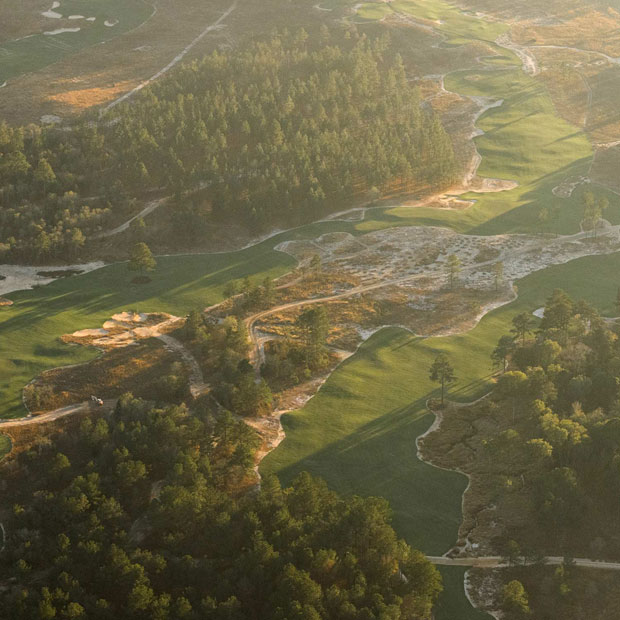Wild Harry Smead: Pine Hills
Pine Hills Country Club and the joyful challenge of severe green contours


I had heard stories about Pine Hills Country Club. Allegedly, Herb Kohler tried to buy the Sheboygan, Wisconsin, club before he developed any of the Destination Kohler courses. Another buddy told me Pine Hills had the best greens he had ever played on.
On our trip back from Michigan’s Upper Peninsula earlier this year, around 5 p.m., Mrs. Fried Egg and I were nearing Sheboygan when I turned to her. “I gotta stop for a minute and go see something.” It was the second such request I had made on our long drive back to Chicago.
“What?”
“I promise it’ll only take 15 minutes.”
We parked outside Pine Hills, and I channeled an activity from my youth: hopping the fence to see a golf course. (There wasn’t an actual fence, and I don’t recommend doing this.)
My first glimpses of Pine Hills breathed an energy into me rarely felt on hour four of seven-hour drives. Aware of Mrs. Fried Egg’s waning patience, I started running. Thankfully, no one was around. I jogged the first five holes, my excitement rising as I saw fairways draped over massive natural landforms and greens bearing the distinctive marks of the steam shovel.
{{content-block-pine-hills-country-club-review-001}}
As I got closer to the putting surfaces, I began to understand that Pine Hills’ little-known architect Harry Smead must have been a master. Inside the large-scale external shapes of the greens, I saw mesmerizing internal contours.
{{content-block-pine-hills-country-club-review-002}}
My brief jog led me to a simple conclusion. I had to come back.
Admiring the greens at Pine Hills—legally
After studying the course more thoroughly (this time with permission and in the light of day), I was even more impressed. While we don’t know much about Harry Smead, most believe that he falls from the Langford & Moreau architectural tree. His shaping style, driven by deft steam-shovel work, certainly indicates that.
At Pine Hills, Smead set 18 holes on dramatic terrain, and he didn’t hold back at the green sites. The greens are truly mind-bending, and I couldn’t help but stare at them and think of the diverse array of pin positions. Smead created Pine Hills in 1928, two years before Langford & Moreau finished Lawsonia Links, and the two courses bear a striking resemblance to each other. Like Lawsonia, Pine Hills stomps the gas pedal on the 1st tee and doesn’t let off.
The opening tee shot plays over big folds in the land that cut in from multiple directions. Golfers then play up a large hill to the first of Pine Hills’ 18 outstanding greens. This one has a swale running diagonally from front left to back right, creating two distinct plateaus, each guarded by deep, steam shovel-molded bunkers.
{{content-block-pine-hills-country-club-review-003}}
At 195 uphill yards, the par-3 5th at Pine Hills is a stern test. Once you reach the green—no easy task in one shot—you will find some of the most remarkable contours I’ve seen. A rolling, diagonal ridge separates the front and back sections. There is also a raised shoulder front right and a pocket on the left tumbling into a bunker. Hitting this green in regulation is tough; two-putting it may be even tougher.
{{content-block-pine-hills-country-club-review-004}}
The course’s most majestic green belongs to the short par-5 12th. Technology has rendered this 453-yard par 5 easy to reach in two for skilled players, but Smead’s green “defends par” with the best of them. It has two spines that sit perpendicular to each other: one bisects the green into front and back halves, and the other divides the front half into right and left quarters. Whereas the front half tilts toward the line of play, the back half runs away sharply. These contours are especially memorable, as greens shaped by the steam shovel are built up and therefore tend to have a back-to-front slopes.
{{content-block-pine-hills-country-club-review-005}}
Pine Hills and today’s aversion to “wild” greens
As great as Pine Hills is, I wonder how the golf world would react to it if it were built today. Almost certainly the greens would be deemed “unfair” or “too extreme.”
We’ve become conditioned to this way of thinking. Water on both sides of a fairway is fair because it’s easy to decipher. Hit it straight and you’re okay; miss and you’re taking a drop. But on the greens, those terms don’t seem to apply. If a golfer finds the wrong section of the green and takes an unavoidable three-putt, that’s “unfair.” What if there were a red line surrounding the offending section that allowed for a drop? Would that be more fair?
On our podcast about Streamsong Resort, Tom Doak remarked that sometimes he wishes there were signs on certain contours: “If you are reading this, you hit it in the wrong spot.” Finding the green should not guarantee a two-putt. In fact, saving the greatest challenge for the greens may be the most equitable test. On and around putting surfaces, physical limitations are moot. Any golfer, of any size or strength or technique, stands a chance.
I’ve often seen Doak’s greens described as too wild, which is strange to me. You don’t hear that complaint as much about older courses like Pine Hills or National Golf Links of America. Yet compared to the greens of Harry Smead or Macdonald and Raynor, Doak’s are tame.
The problem is, in order for boldly sloping greens to work, they need to roll at a slower speed than many 21st-century golfers are used to. Slower greens open up more interesting pin positions and create more interesting shots. But a straight putt over a glass-like surface seems to be the preference these days.
Maybe that’s linked to the notion of fairness. After all, a four-foot putt on a slower green that has to start a cup outside is more likely to fail than one on a green “rolling 14” that you play inside left edge. When a challenge presents itself that close to the hole, where the expectation is a make, it can be construed as unfair or too severe. But it’s just another type of examination—and a good one. On a four-foot slider, pace and line have to be in perfect harmony, as do your hands and your mind.
Pine Hills may violate certain ideas of fairness, but it’s an equitable test. The movement of the land renders fairway bunkers virtually unnecessary. Forced carries are rare as well; there are just a handful over Pigeon Creek. The challenge comes in two places: the terrain and the greens. While strong ball-strikers have the advantage in navigating the severe topography and avoiding uneven lies, the slopes in the fairways will lead to missed greens, and that’s where short-game wizards can thrive. The greens and surrounds reward players who possess imagination and delicate touch. So Pine Hills is not just a ball-striking test; it examines the full bag of skills.
On many courses, we’ve come to expect the thrill to be over once we get to the green. But I would argue that the green is where great architects separate themselves from good ones. The greats can pack thrills on the miniature scale of the putting surface, even when there are no natural features to work with. Managing this feat 18 times in 18 different ways takes real talent and skill. But basing green designs on the concept of fairness is the shortest path to TPC blandness.
Pine Hills Country Club has 18 unique greens, each with an identity defined by internal undulations. Sure, they can set the stage for the pain and frustration of three-putts, but golf is about overcoming obstacles. So when you visit any course with supposedly “wild” greens, I invite you to turn yourself loose, hop the fence, and see if you can find delight in them. At Pine Hills especially, if you put aside thoughts of fairness, you’ll be rewarded with one of the Midwest’s most thrilling golf adventures.
For golf fans who want to bring home a piece of this course, we offer a collection of Pine Hills photography prints shot by the Fried Egg Golf team available in our Pro Shop.
Sign Up for The Fried Egg Newsletter
The Fried Egg Newsletter is the best way to stay up to date on all things golf. Delivered every Monday, Wednesday, and Friday for free!
Leave a comment or start a discussion
Engage in our content with thousands of other Fried Egg Golf Club Members
Engage in our content with thousands of other Fried Egg Golf Members
Get full access to exclusive benefits from Fried Egg Golf
- Member-only content
- Community discussions forums
- Member-only experiences and early access to events












Leave a comment or start a discussion
Lorem ipsum dolor sit amet, consectetur adipiscing elit. Suspendisse varius enim in eros elementum tristique. Duis cursus, mi quis viverra ornare, eros dolor interdum nulla, ut commodo diam libero vitae erat. Aenean faucibus nibh et justo cursus id rutrum lorem imperdiet. Nunc ut sem vitae risus tristique posuere. uis cursus, mi quis viverra ornare, eros dolor interdum nulla, ut commodo diam libero vitae erat. Aenean faucibus nibh et justo cursus id rutrum lorem imperdiet. Nunc ut sem vitae risus tristique posuere.